Commercials 6 – Other Pole Gear
| Having looked at the poles themselves last week, it’s time to look at the essential equipment needed to complete the kit.
Watch an experienced pole angler in action and they seem surrounded by mountains of complex paraphernalia. Yet what is just for show and what is essential? I’ll try to guide you through the maze, starting with what to sit on, and also cover nets, floats, hooks and line, plus one or two other gadgets. One difference with pole fishing is that with few exceptions it is a method of fishing that is best performed sitting down. And how you sit down is important. I fish on rivers a lot; some of the time I stand to trot, at other times I sit on a roving chair to leger for chub, staying low. But fishing with more than about five metres of pole is much easier if you can sit upright on a stable platform, and this applies to stillwaters as much as rivers. Roving chairs, as just mentioned, are not suitable for pole fishing because you are too low to the ground. 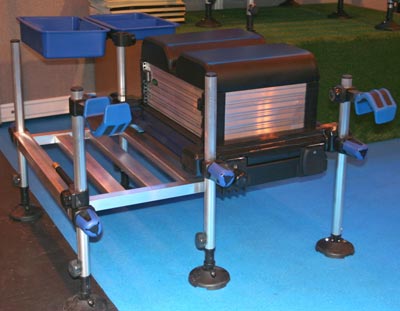  The most popular seat for pole fishing is a continental type seat with a built in cushion and some means of levelling the base through the use of adjustable legs. Because these boxes are purpose built for pole fishing they have trays that slide out so that pole winders and other bits and bobs are available without having to get up all of the time when fishing. This means that with a little thought you can get really well organised so that you don’t need to keep getting up off the box all of the time. Experienced match anglers have this economy of movement to a fine art, with bait, spare hooks, nets, spare pole tops (often tackled up with alternate rigs all to hand. When they catch a fish it is unhooked in the landing net, eliminating the need for an unhooking mat before being slipped into the handily placed keepnet. Although continental type boxes have been around in Britain for over thirty years it was only when manufacturers in Britain got their act together about fifteen years ago that they really took off. Boxes like the AS1 and Boss took the match fishing scene by storm. What made the difference? It was the addition of adjustable legs, an add-on that was quickly gaining popularity due to the Octoplus kits that were being added to Shakespeare boxes by the thousand. Suddenly the dedicated pole angler had the fishing station that was perfect. In addition, platforms made of aluminium alloy meant that the pole angler could get support for his feet. The drawback to these boxes at the time was two-fold; the cost at around £ 400, and their heavy weight. But since then huge competition means that lightweight versions to suit all pockets are available. I must admit that I have stuck to my near indestructible Shakespeare box with Octoplus legs for twenty years. Both products are totally reliable and tough as old boots. Because I do less pole fishing than most, and often use a roving chair a lot, I see little need to change, but if I were to pole fish much more then I would take another look at the continental boxes. The advantages of them are the organisation the drawer system offers plus increasingly the special moulded top cushions that are purpose made for pole fishing. As for platforms and the associated kit, my recommendation is that you only consider this if you are getting seriously into pole fishing, especially in matches. These have all sorts of add-ons; special pole rests, bait waiters, and means to attach keepnets and rod rests. Nets Regardless of what water you fish you are going to need a landing net. One of the recent benefits of the popularity of commercial carp waters is that the ideal landing net has evolved. These are known as spoon nets, and one in a 24″ or 26″ size is easily man enough for carp to double figures (don’t bother with nets less than 20″ diameter under any circumstances, and believe me there is no need for a 42″ carp net on the average commercial). Make sure that the one you buy has the Angling Foundation fish friendly symbol. With that you’ll also need a strong landing net pole. 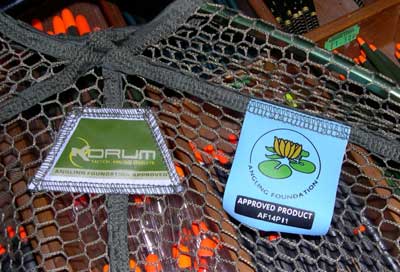  Unless you are going to fish matches you won’t need a keepnet. If you are going to fish matches on this type of water you will find that you will need two keepnets; one for carp, and one for other fish. Again, make sure that they have the fish friendly symbol. I would recommend that the keepnets you buy are a MINIMUM of 3 metres, with dimensions of 50cm x 40cm. There are legal nets that are smaller than this but why compromise when fish welfare is at stake? One match anglers’ saying that has always stuck in my mind, and it applies to all anglers, is “Look after the fish, and the fish will look after you”. It’s worth mentioning unhooking mats at this point; a few fisheries insist on them, most match anglers manage well enough without through the routine of unhooking the fish whilst sitting and the fish still in the net but not on the ground. Certainly avoid putting fish on the ground especially on platforms, gravel or rock hard ground, unless it’s lush wet grass. A cheap unhooking mat won’t break the bank and should be an option if you’re starting to get a few carp that are into double figures. Other bits and pieces Some pole winders will be useful. A couple of plummets, an elastic threader and pole elastic lubricant are essential. Also get some spare Stonfo connectors and a packet of the very fine tubing in different diameters to use as float rubbers for pole floats. Make sure you have some disgorgers; they’re cheap enough so get several. Scissors and a hook tier will come in useful when it comes to tying hooks. 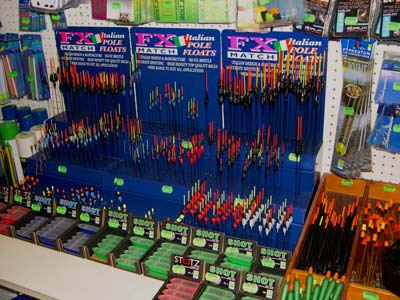  A pole roller on some sort of adjustable double tripod is essential for fishing at more than about 6 metres. As you progress to fishing a pole at longer lengths you will find it necessary to have some means of supporting the pole as you ship it back. If I’m fishing at only seven metres then I often use my rod holdall laid sideways to ship the pole onto, but beyond this length you definitely need a roller. 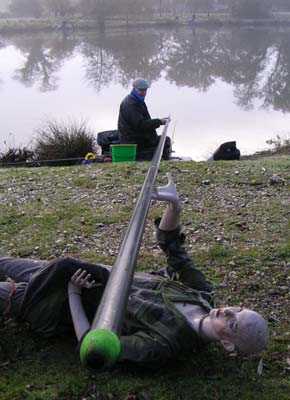  Floats As with all floats there are myriads of patterns for pole fishing. As I cover specific methods later in the series I shall show suitable floats. One facet of pole floats is that the amount of weight that they carry is much less than a comparable float that you might use for regular float fishing in similar conditions. So where you might use a waggler float taking 2AAA shot the same would be covered with a pole float taking about a quarter of that, say 0.40 grams. For the run of the mill shallow commercial water you may find that it is rare to need a float taking more than about 0.50 grams. If fishing much deeper water or rivers then you will need floats that take from 1 gram and upwards. 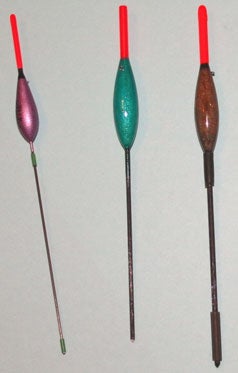  Pole floats mostly have balsa wood bodies. As a beginner I’d urge you to stick to ones with a body shape like an elongated rugby ball. A type of float known as a dibber is also useful, especially for fishing very shallow. What does vary considerably are the tip and stem materials. The stem below the body is usually carbon fibre or stainless steel wire. I prefer the tough carbon stemmed ones though wire can be more stable. Tip materials vary from wire (OK for dedicated bloodworm anglers looking for the tiniest bites as it’s so thin), through nylon, fibreglass and cane. A few models have an all balsa tip (the thickest of them all). There are only three things you need to know about float tips, regardless of material. One, can you see it? In different light conditions different colours may help; against a white sky black is often best, against green reflections yellow or red may be better. Some floats allow you to change tips which can be handy. Some tips that are made of translucent fibre can show up particularly well. Two, is the tip sufficiently buoyant to hold up in the conditions, and to support the weight of the bait? Some of the baits like sweetcorn are the equivalent of a dust shot and this may need to be taken into account. In windy conditions there may be drag on the float that means ensuring the float is not getting dragged under constantly. Finally three, the material the tip is made of has no effect on its residual buoyancy, only the volume that remains to be displaced. If you disagree with that statement you will have to prove me and Archimedes wrong. £ 100 says I’m right! As far as this is concerned what is worth knowing is that if you double the thickness of the float tip then you quadruple its buoyancy. 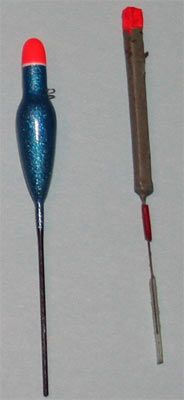  To start pole fishing you will need a small selection to start with. Assuming you will be tackling a relatively shallow stillwater; say up to six feet deep, then a selection taking from 0.3grams to 0.75 grams will be a starting point. A dibber or two (only an inch or two long) for fishing shallow is also useful and these will have a very small shotting capacity of the equivalent of a couple of no. 8 shot or less. If the water you intend tackling is much deeper, like the old clay pit I mentioned earlier in the series then floats taking from 0.5 grams up to as much as 2 grams will be better suited, though I would still get some smaller ones for surface fishing. Line You will need some spools of line to make rigs up with, and to tie your hook links. Whilst a spool of cheap reel line will do the job it is worth understanding the qualities that are needed for lines used in pole rigs. Because the pole elastic acts as a shock absorber there is less need for stretch in the line itself. 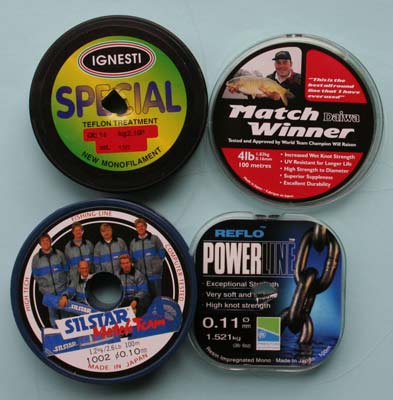  Furthermore, the line does not get the abrasion that is caused by it being constantly spooled onto the reel. What this means is that you can use a line that is one of the modern co-polymers with reduced stretch and reduced diameter in all but the most demanding of fishing situations. As with much of fishing everyone has their own preferences, but sounding out a few on Fishingmagic, there were mentions of W B Clarke Match Team line, MAP Carptec, and Preston’s Reflo Powerline. To start with get some in these diameters, 0.10, 0.12, 014 and 0.16. With these high-tech lines that will give you a spread of breaking strains from about 2lbs to about 5lbs. This will also give you some hooklink line as well to tie your hooks to. As mentioned in the previous article it is vital to match your line and hooklink to the elastic that you are using. And it is vital to match the strength of the elastic, line and hook to the size of fish that you are targeting. In your rig there has to be a weak point so that if you get snagged or broken by a fish then the weakest link MUST be your hooklink, and don’t be tempted to massively uprate your line twinned with mega strength elastic; you might just find it is your pole that breaks… 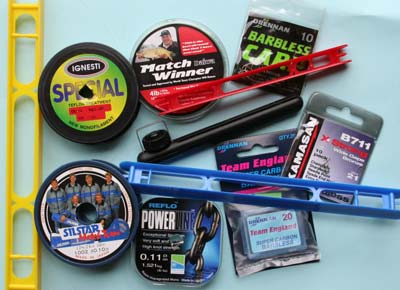  Hooks Most commercial waters and many club stillwaters insist on barbless hooks. Nowadays, we are spoilt for choice in hooks suitable for all types of fishing, and this type of fishing is no exception. One of the many skills that are worth learning for pole fishing is the ability to use a hook tier to tie spade-end hooks to line. By doing this you can choose what hooks and what hooklink to use. Take the trouble to practice, possibly seeking a little help in the first place to get the basics right from someone able to show you how, and you will be able to tackle any situation. Tips for good hook tying include getting the tension right as you tie the hook. Too much and the line will kink and curl, too little and the knot will slip. Make sure the line comes off the inside of the shank/spade. Don’t forget that you can tie eyed hooks with a hook tier (NOT through the eye). 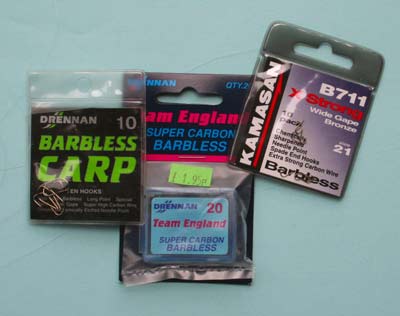  What hooks to use? Kamasan B711s are one of my favourites; they’re strong and sharp. Many match anglers swear by Tubertini 808. For fine line maggot or caster fishing hooks like Drennan Team England in a size 20 should fit the bill. One final requirement for pole fishing is some small split shot; nos. 8 and 10 in lead, and 6, 4, 1, BB and AAA in non-toxic (Anchor seem best). Use the bigger shot in groups to form a bulk and the tiny lead sizes as droppers. We’ll start looking at shotting patterns from next week when we finally get to do some fishing! Checklist Essential
Useful
Next week: First venture out with a pole. |










